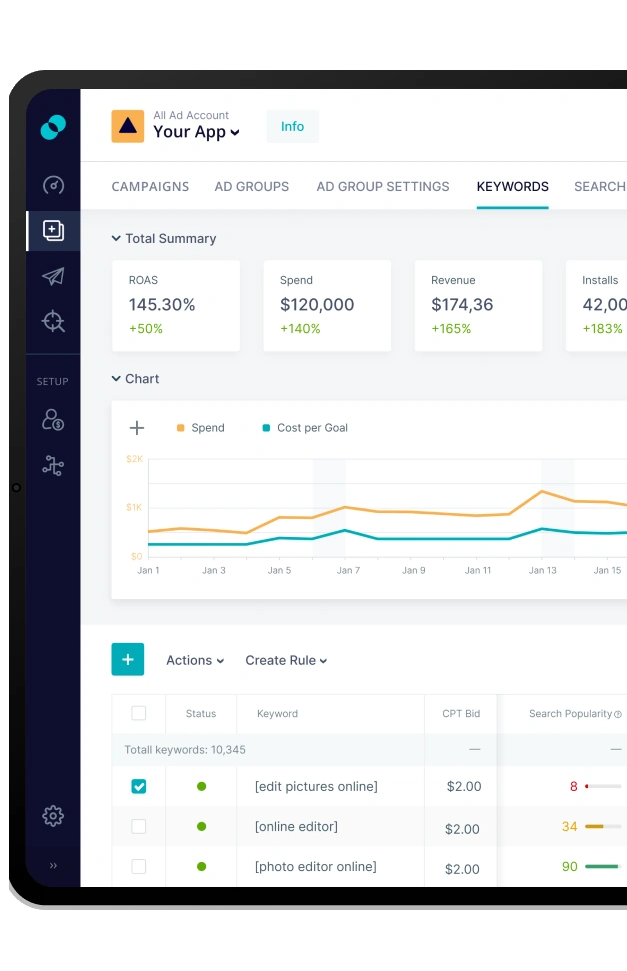Apple Ads Keywords Performance: TTR, CVR, CPT & CPA
 Anastasia Sidoryk
Anastasia Sidoryk  Anastasia Sidoryk
Anastasia Sidoryk More and more app marketers are using Apple Ads as a prime mobile user acquisition channel.
When you promote iOS apps via this network, you enter the most common app discovery place – App Store search: as per Apple, 70% of App Store visitors use search to look for apps, and this search generates 65% of all app installs. It makes sense to compete for the blue-colored ad spot, isn’t it?
Another advantage of Apple Ads is its impressive average conversion rate of around 50%. Additionally, iOS app publishers who use this user acquisition channel get access to high-quality users willing to download and subsequently interact with the app.
But to manage Apple Ads successfully, it’s reasonable to understand all about its core – keywords. We’ve already written about keyword expansion in Apple Ads. This time, we’ve focused on their performance, which results in the data-backed report you’re reading now.
Apple Ads keywords performance report is based on the data of our top spenders, gathered from July 2018 to January 2019:

The report covers the following:
While you examine the report, keep in mind that the findings are not necessarily representative of the entire market. These are the statistics we’ve collected from the accounts selected on the ground of their spend.
In a full version of this report, you can also discover our findings on how long keywords should be to boost your ad performance. Get benchmarks for TTR, CVR, CPT, and Cost per Acquisition by word count and match type, and learn the optimal Apple Ads keyword length.
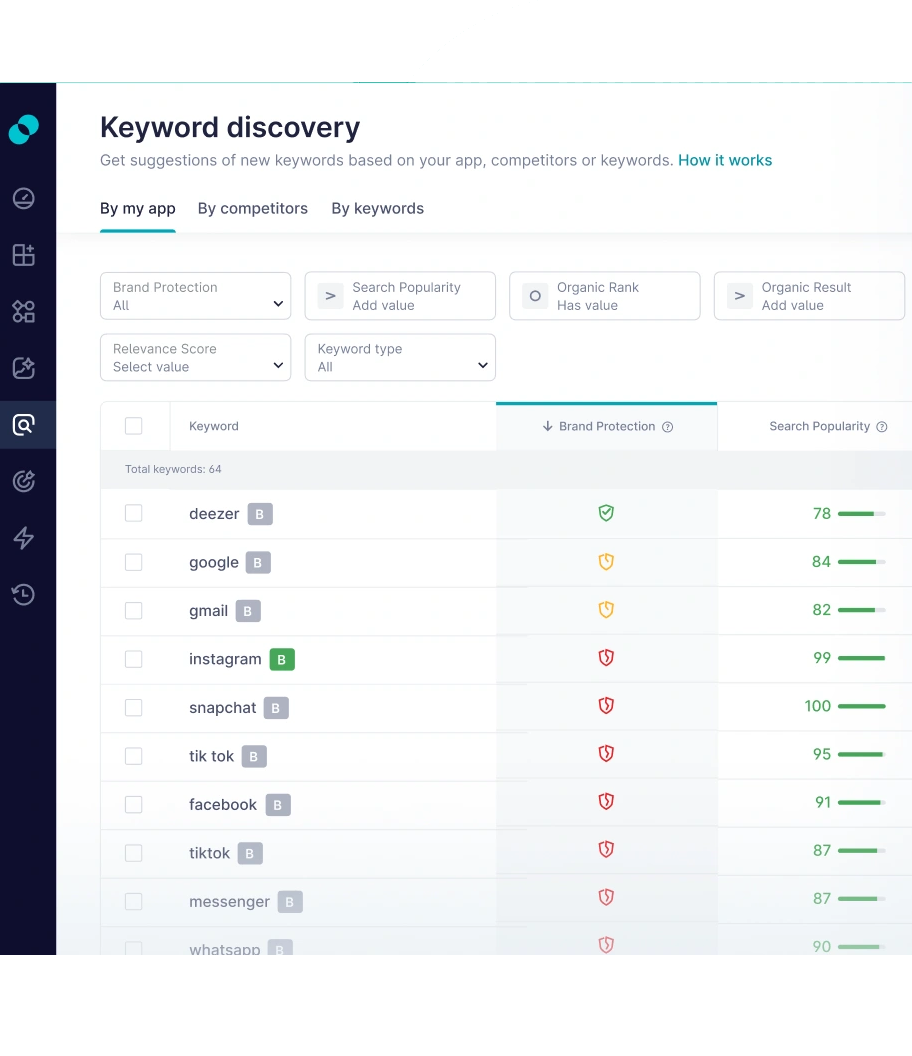
Publishers who market their apps via Apple Ads are free to structure their accounts the way it fits their needs and desires. There are three account levels in Apple’s platform – Campaigns, Ad Groups and Keywords – which are closely in sync with SearchAdsHQ.
We’ve analyzed top spenders in our platform and their ad account components, and here are our findings:
Unsurprisingly, it has turned out that SearchAdHQ top spenders are big publishers who run Apple Ads for more than one app – 4 apps on average.
Campaigns can be brand, generic, competitors or discovery. Based on your goals for a campaign, you set a specific audience, device and match type at the Ad Group level, and do it for each of the needed storefronts. The possible variations produce such a value – 34 campaigns per one app on average with 3 ad groups per campaign.
One level down the Ad Groups is Keywords. There are 79 keywords per ad group on average, including both active and paused keywords that generated at least one tap within the selected period.
If you have ever been running Google Ads, Apple Ads match types will be familiar to you:
The research of top spenders in SearchAdsHQ has revealed that the average number of keywords per app (counted for all the 13 storefronts) is 8,099. In the chart below, you can see how keywords are distributed by match type, both in terms of numbers and percentage:
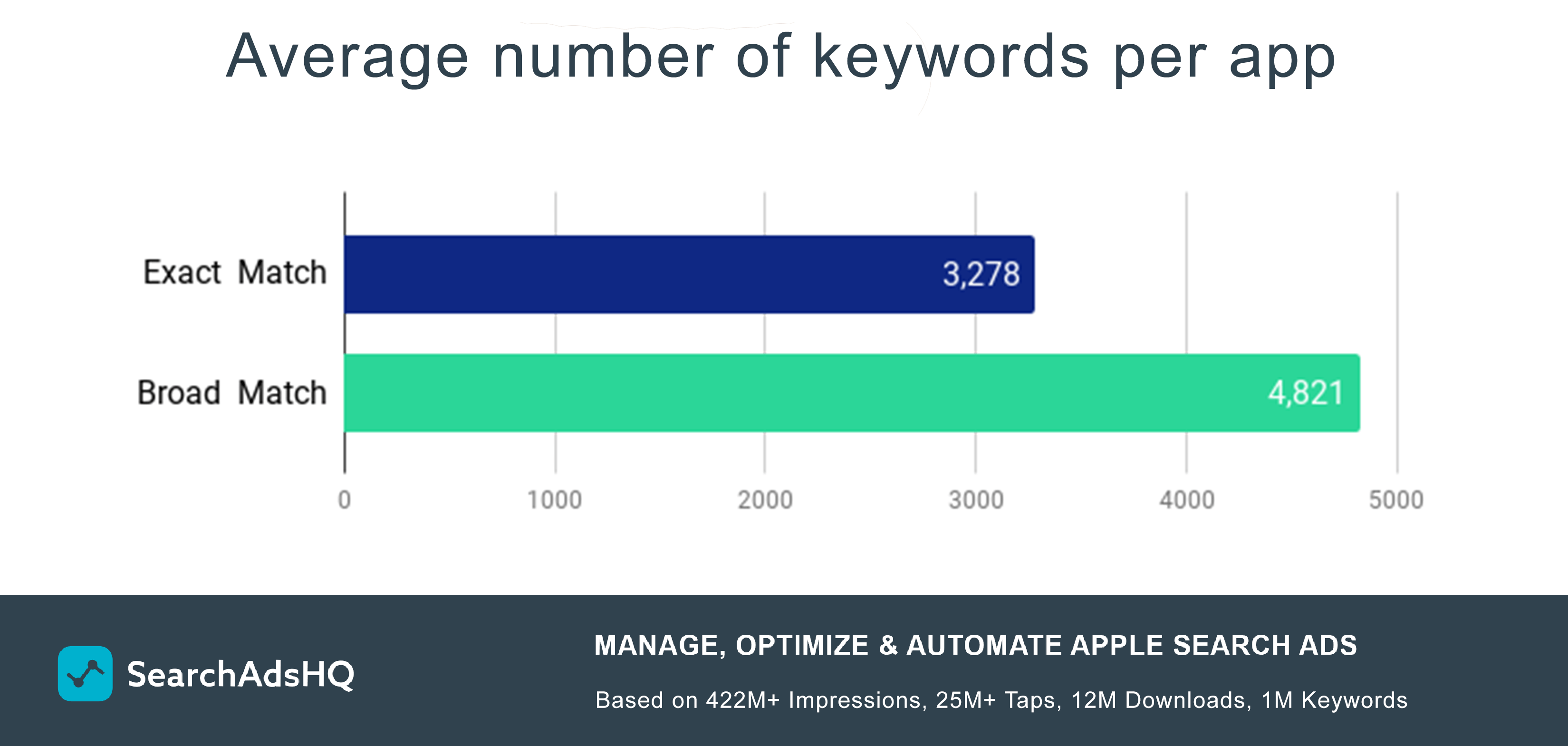
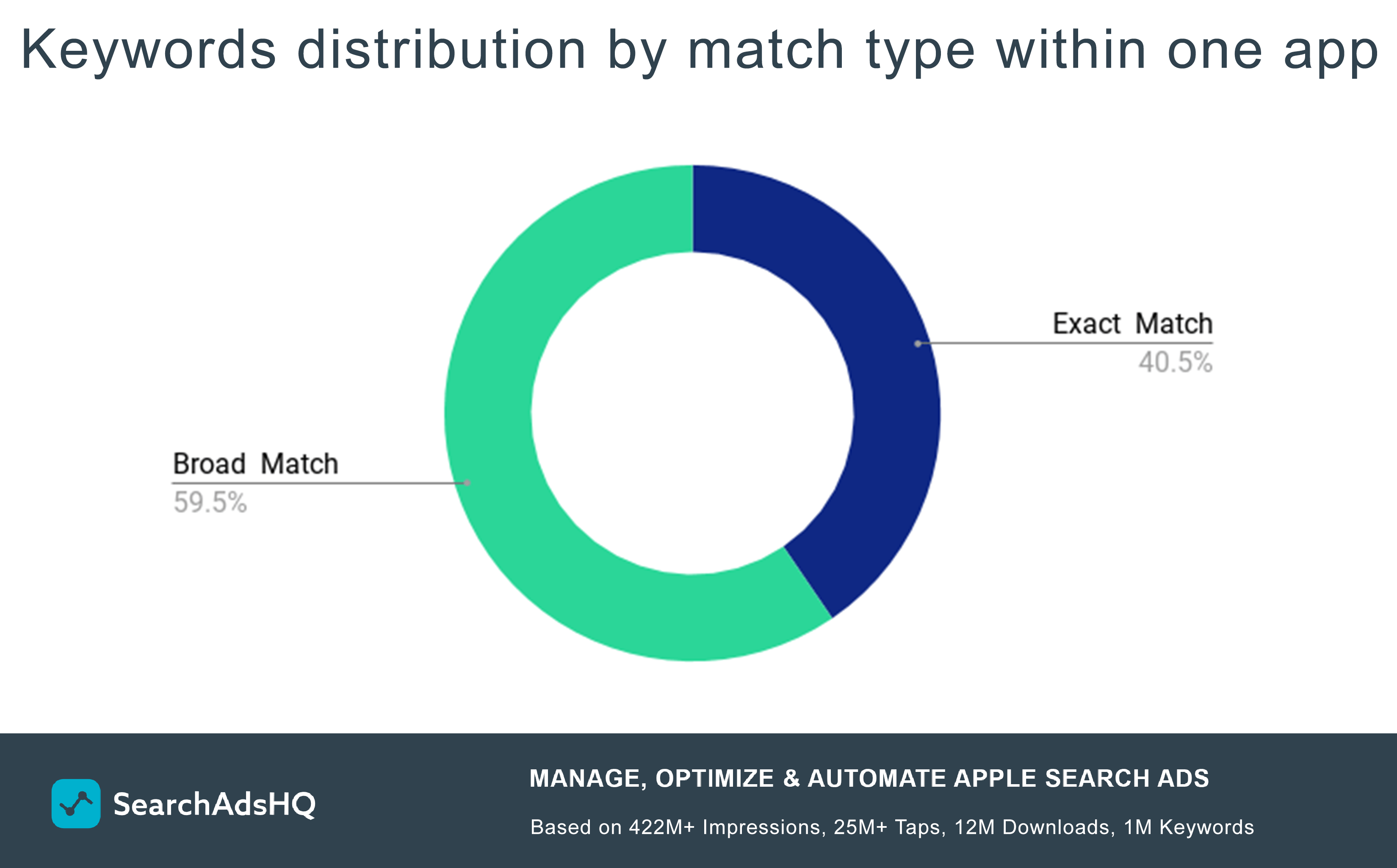
Obviously, the distribution is unequal. Exact Match accounts for 40.5% of keywords, compared to 59.5% of Broad Match keywords. However, when it comes to spend distribution the scales tip towards Exact Match: 15.1% against 73.1%:
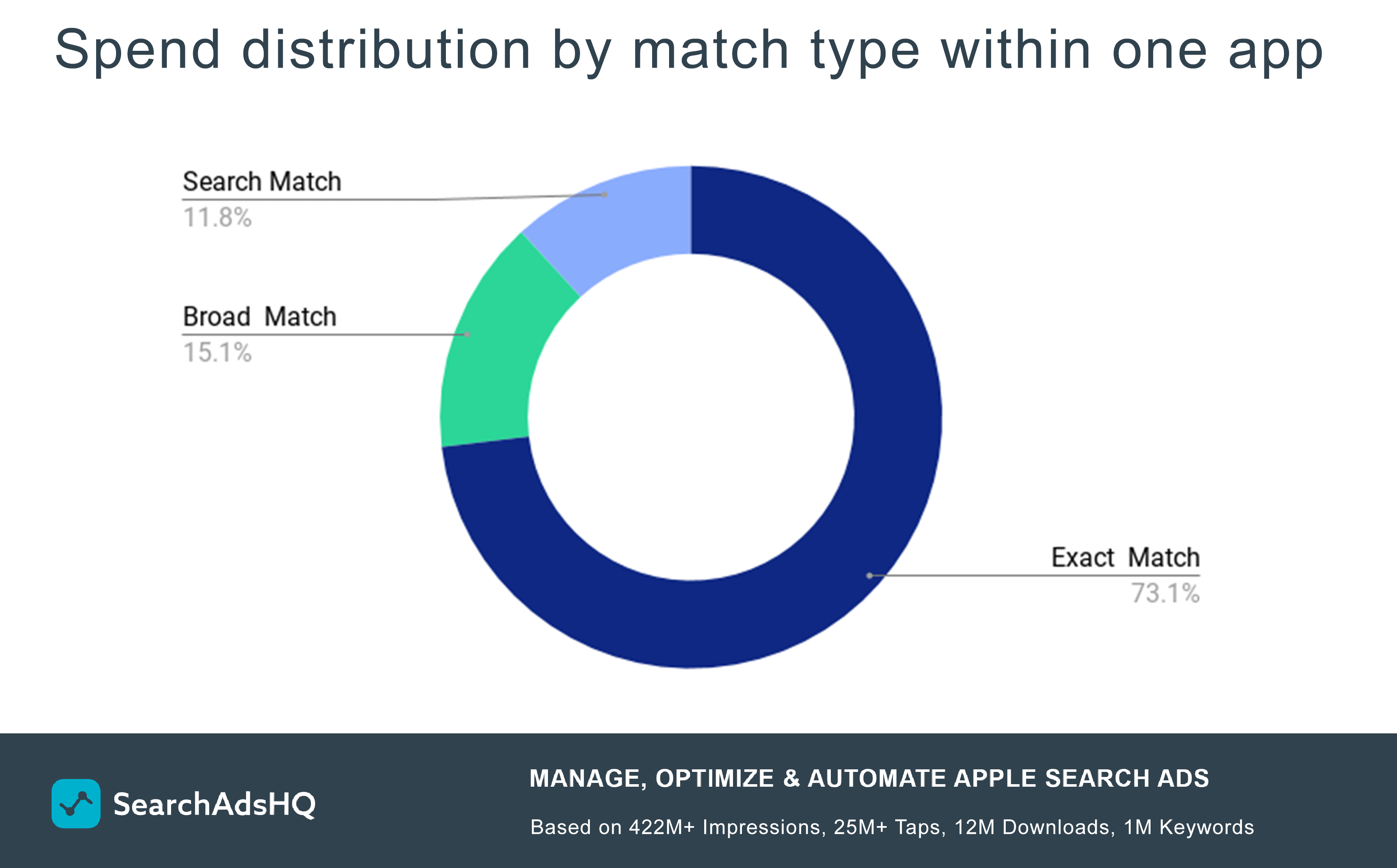
Exact Match keywords are capable of managing your relevance to the user search query. They help pull in interested users, who are more likely to convert and bring in revenue in a while. Such keywords cost more, but our top spenders are willing to allocate a bigger portion of their budget (compared to Broad Match) because this will eventually pay off.
In addition to the two match types, there’s Search Match, which is specific to Apple’s advertising network. The good thing about this feature is that it does all the dirty job of manual keyword research automatically.
Since you indicate a separate CTP bid for your Search Match campaign, Apple Ads will offer only those keywords that align with your budget. As for SearchAdsHQ top spenders, they allocate around 11.8% of their budget for Search Match on average.
As a rule, Broad and Search Match are used in Apple Ads discovery campaigns to find high-performing keywords. Based on the charts above, our top spenders allocate slightly more than 20% on running discovery campaigns and approximately 80% on exact campaigns.
In general, 20/80 is the recommendable budget distribution, especially when you start building your account. In a while, the budget share allocated for keywords research can be lowered. Our findings on match types performance (see below) show that for SearchAdsHQ top spenders Search Match turns to be more efficient than Broad Match. This makes Broad Match a possible area to cut your budget.
In Apple Ads, you can set keywords as Exact or Broad Match.
Exact Match keywords are intended to attract users who search only for those specific keywords or their close variants. True, they can generate less impressions, but TTR and Conversion Rate will be higher compared to Broad Match keywords.
Broad Match is a more aggressive match type which aligns your ad with plurals, misspellings, related searches, synonyms, partial words, etc. Having run a Broad Match campaign for a while, you can explore your report for well-performing keywords to be transferred to Exact Match groups. This is how you run Apple Ads discovery campaigns in a nutshell.
Knowing that the overall performance of keywords will differ by match type, we’ve carried out a deeper analysis that covered:
An impression happens whenever your ad appears in App Store search results. The research of SearchAdsHQ top spenders has revealed the following distribution of impressions across the three match types:
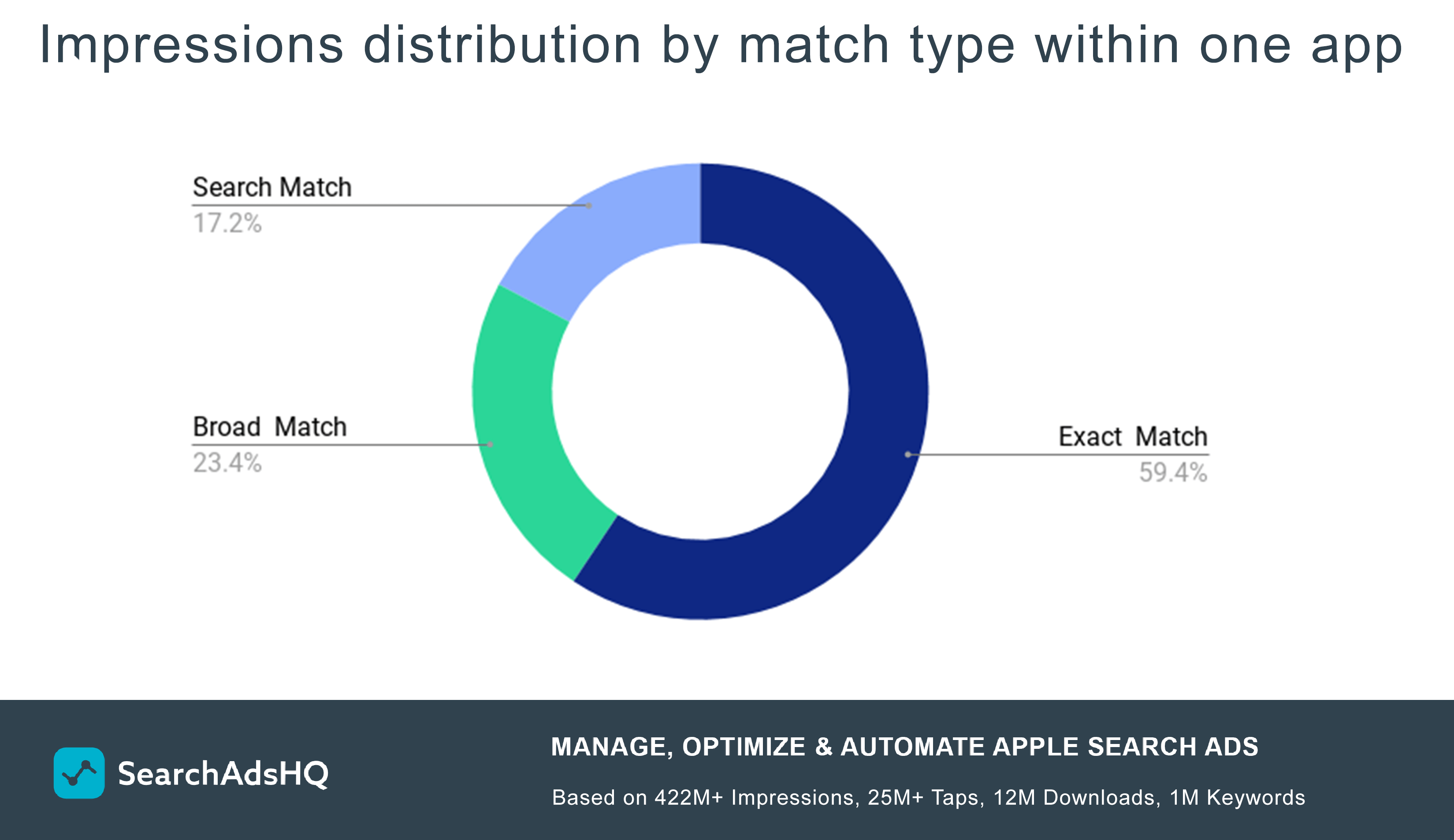
According to the chart, Exact Match keywords have triggered 59.4% of impressions, which is more than Broad Match (23.4%) or Search Match (17.2%). Such a distribution can be explained by the fact that SearchAdsHQ top spenders allocated a bigger budget portion for Exact Match groups rather than Broad Match or Search Match (see the statistics on Spend above).
Important: Whenever we speak about Search Match groups, we refer to search terms, not keywords. Keywords are applicable to Exact or Broad Match groups only.
Exact Match outperforms Broad Match when it comes to TTR as well. TTR is the number of times users tap on your ad divided by the total number of impressions.
Unlike Broad Match, Exact Match gives you tight control over matching to user search queries. If you set Exact Match for a keyword, your ads will be shown to users who enter exactly this query or its closest variant. By this means you attract interested users ready to tap, hence TTR will be higher in relation to Broad Match keywords.
Our heavy spending accounts are no exception: Exact Match keywords have shown a higher TTR compared to Broad Match ones – 6.34% against 4.41%. However, mind that Search Match performed better compared to Broad Match. It turns out that Apple’s algorithm can do a better job of targeting ads to keywords automatically than you do by picking keywords manually.
As a rule, we suggest arranging discovery campaigns into two separate groups – Search Match and Broad Match. However, based on the research of our top spenders, Broad Match lags behind Search Match in terms of TTR:
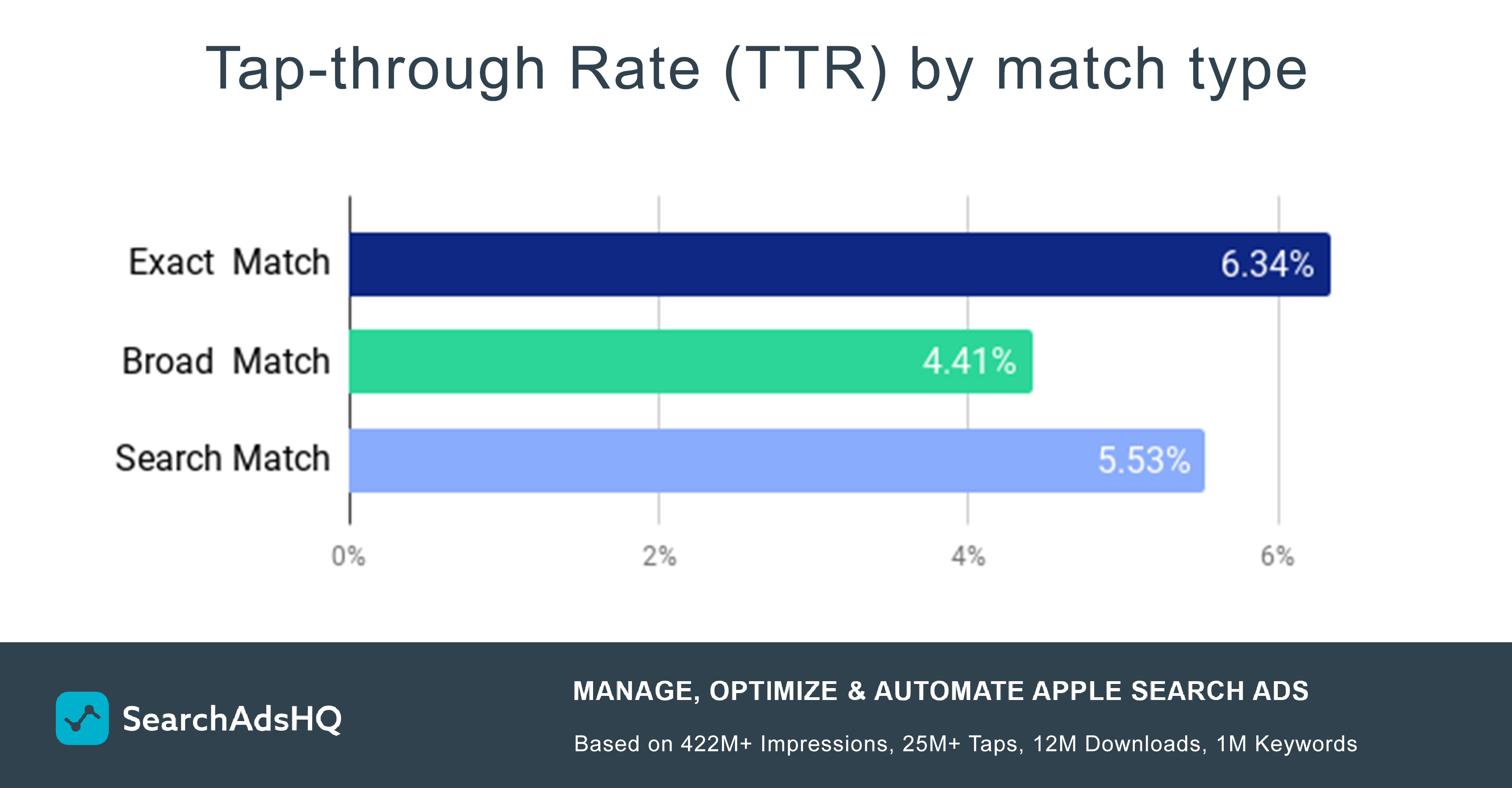
We recommend two possible approaches to dealing with such a scenario:
Keep in mind that our suggestions are not Apple Ads best practices by any means. They are possible solutions, which can be especially helpful if you are pressed for time or have a limited budget.
Conversion Rate (CVR) is the measure of downloads received from taps within a certain period. Check out how the three Apple Ads match types performed for our top spending accounts:
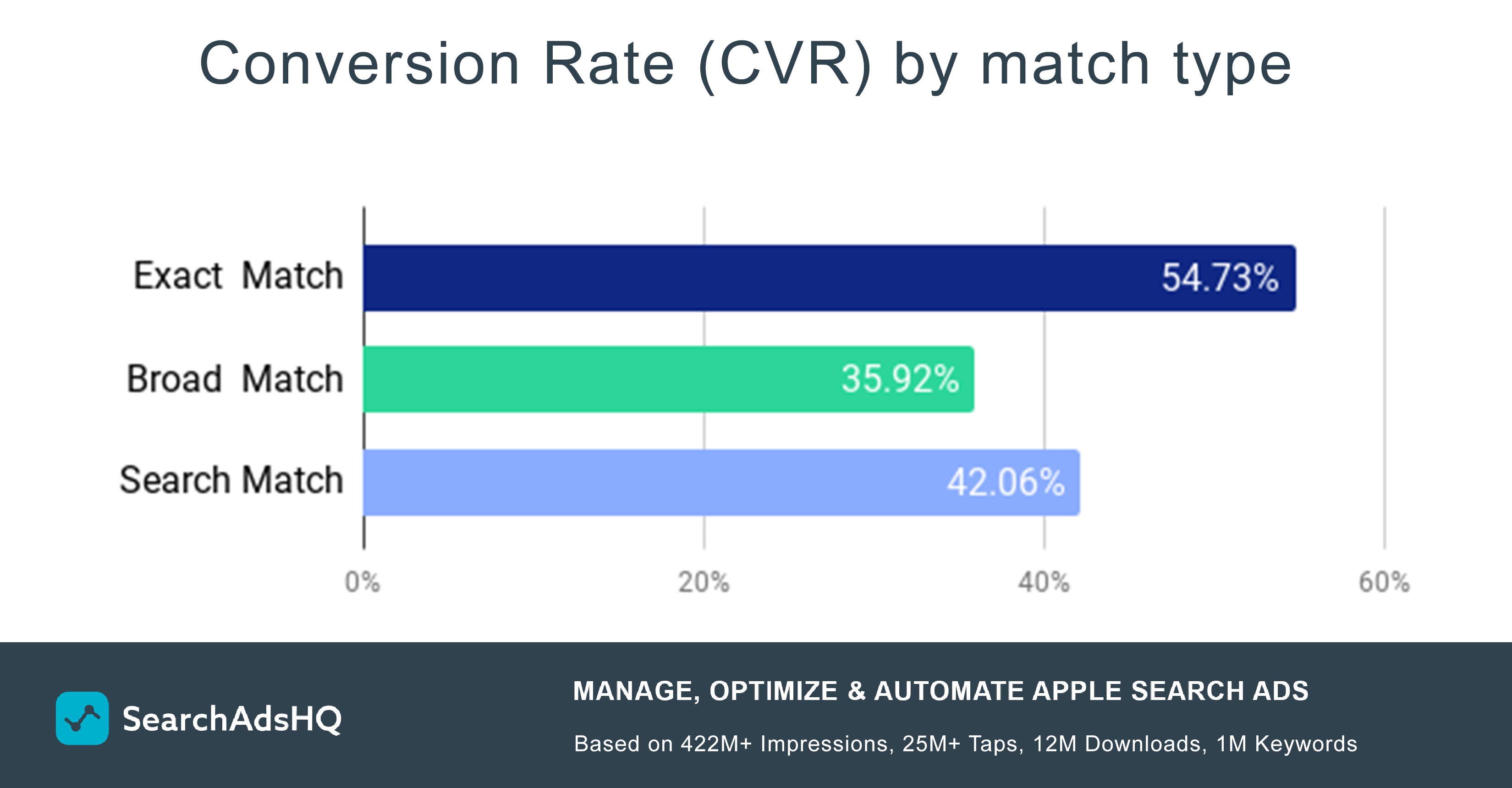
Similar to TTR, Broad Match is the least performing match type of the three in terms of CVR. Such underperformance has to do with the fact that Broad Match gives you less control over matching to user search queries. Your ad may be shown for highly irrelevant queries. Users tapping on your ad find themselves on your app page and realize that this is not what they are searching for. As a result, they leave your app page without downloading.
Things are different with Exact Match keywords, which help you get relevance under control. They produce a way bigger CVR in relation to Broad Match. In the case of SearchAdsHQ top spenders, it’s 54.73% against 35.92%.
Additionally, Search Match performed better than Broad Match in terms of Conversion Rate again. It all adds up to the fact that you can give this Apple’s feature a try if you have a limited budget or no time for manual keywords research.
If you run Apple Ads, you already know that you pay only when a user taps on your ad banner. CPT is both an underpinning pricing model and a metric to track how much taps cost you.
The research of our top spenders has revealed an interesting difference between Exact and Broad Match keywords, and Search Match.
Exact Match keywords have the highest average CPT across all the match types – $1.09. In fact, such keywords cost you more, but they are highly relevant and boast stronger TTR and Conversion Rate metrics. They have a big potential to bring quality, high LTV users, so the costs you incur will pay off in the course of time.
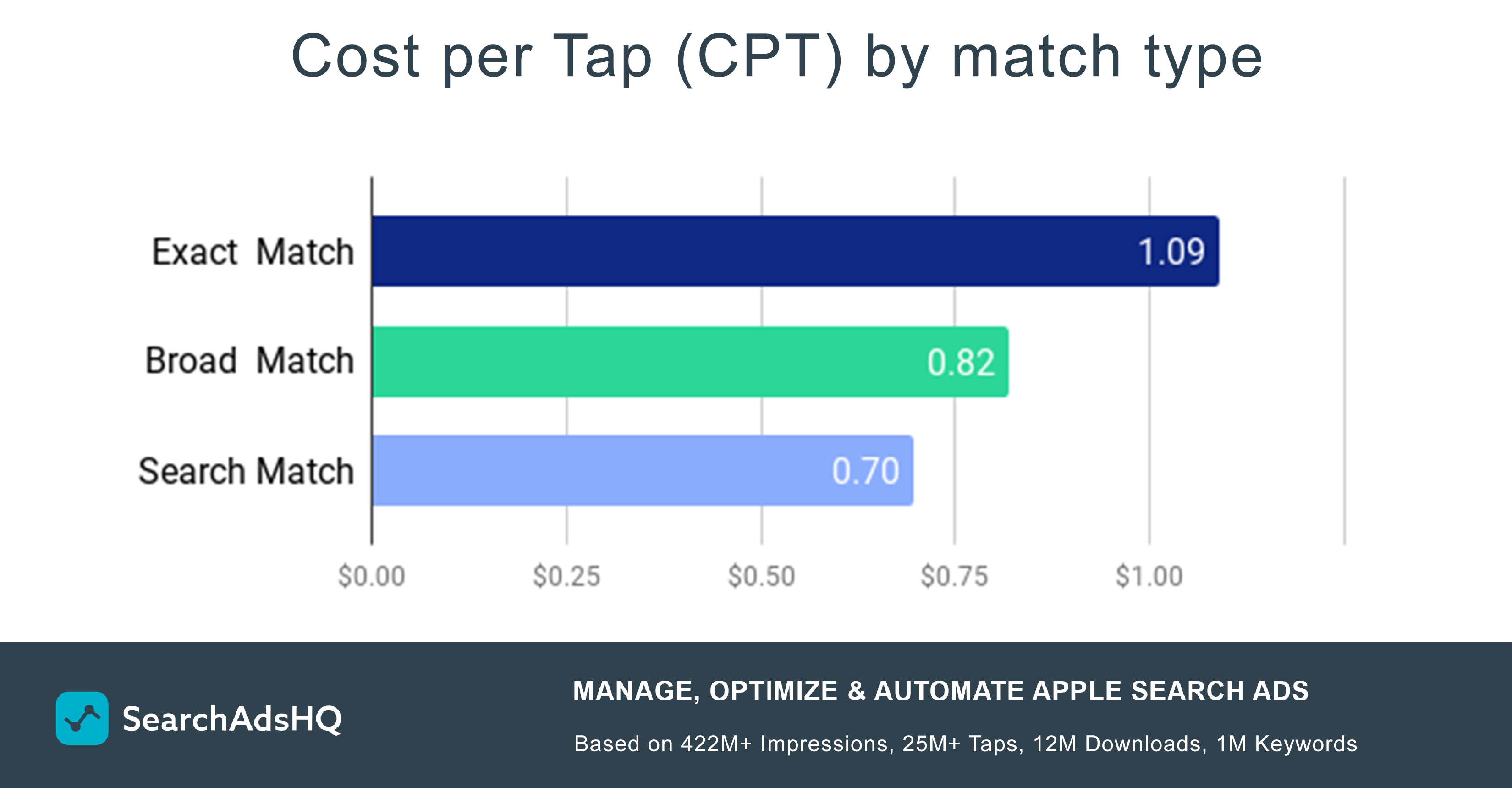
In other words, Exact Match keywords are expensive yet they boast high ROI/ROAS, and top SearchAdsHQ spenders are ready to bear such costs.
Another metric Apple Ads marketers keep top-of-mind is Cost per Acquisition (CPA). CPA indicates how much you pay for every “Get” tap and is calculated as a total spend divided by the number of conversions. For SearchAdsHQ top spenders, the overall picture of CPA by match types is the following:
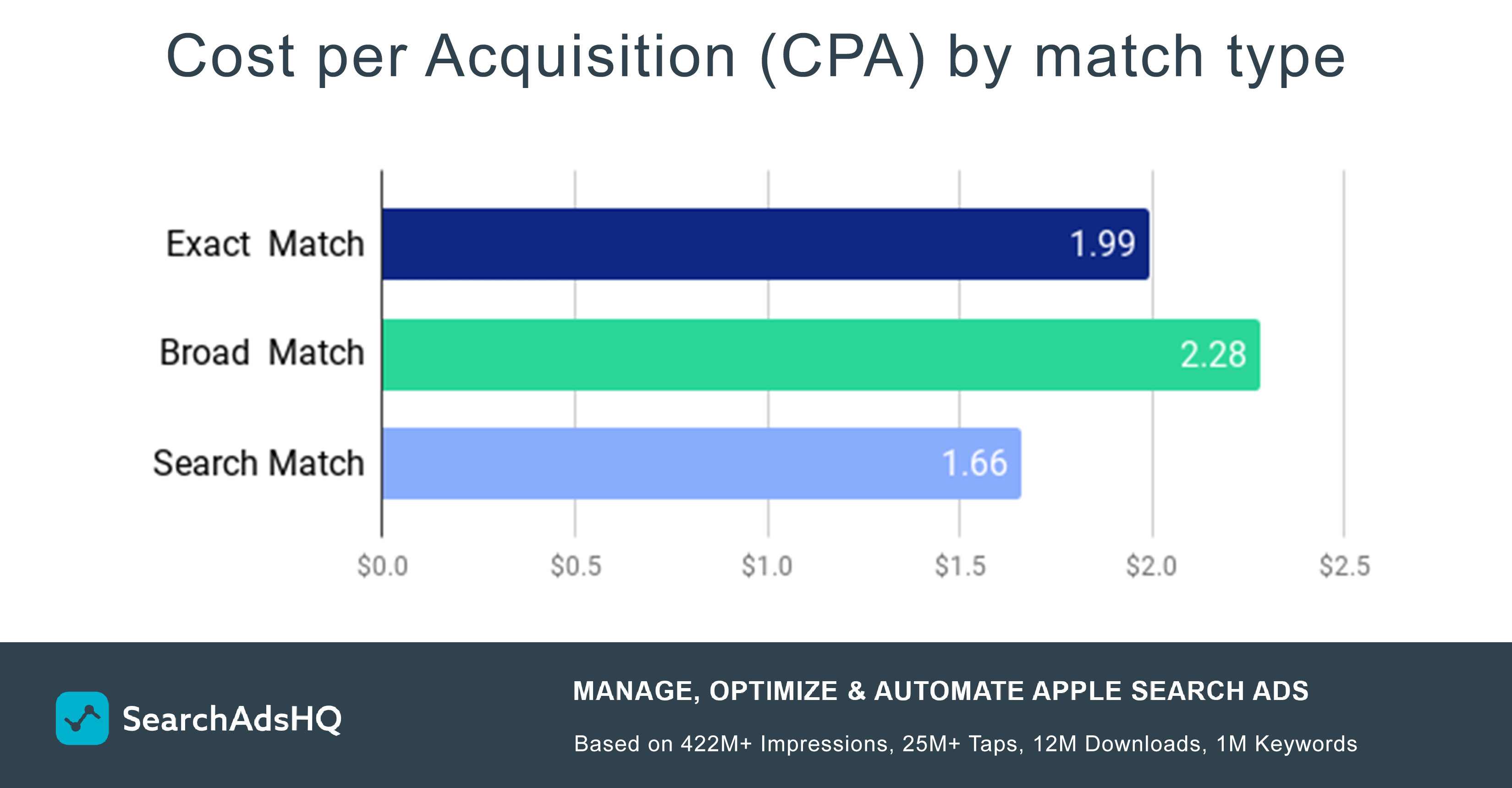
Search Match is in the lead here. It has turned out that manually picked keywords (Broad and Exact Match) can perform worse than those selected by the algorithm. Apple can be very helpful in matching your ads to relevant search terms. There’s no point in ignoring this Search Ads default feature when you manage your ad account.
As for Broad Match, its CPA appeared to be the highest of all. Due to the poor control over relevance to search queries, this match type may generate fewer downloads, hence such an increased Cost per Acquisition.
We recommend to be very careful with Broad Match or even give up on it if you have a limited budget and time. Instead, focus on Exact Match keywords optimization and use negative keywords.
Get benchmarks for Impressions, TTR, CVR, CPT and Cost per Acquisition by word count and match type in a full version of the report. Perform your Apple Ads keyword optimization based on data.
